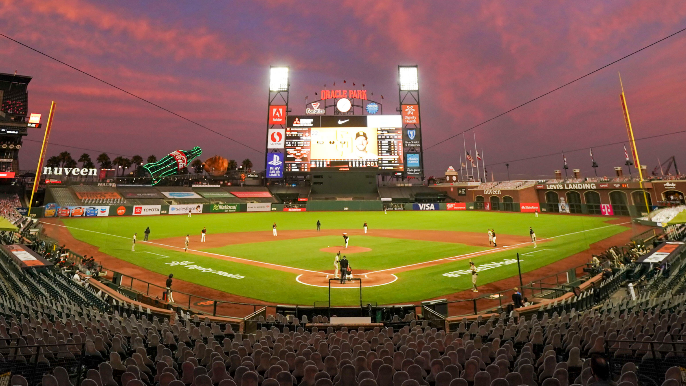The fans are back, universal good news for everyone around Oracle Park.
The tarps in right field are back, too, and it certainly seems as if that is good news for at least the hitters around Oracle Park.
The viewing area in right field was taken away during the pandemic-marred 2020 season, the Giants covering it up to dissuade fans from congregating nearby the water to watch the game. The Giants blocked off peering eyes but also a cold wind from blowing into the park.
Mike Yastrzemski, who played a lot of right field last season, welcomed the development because previously, “I’m out there in the middle of July and August with hand warmers in my pocket,” he said recently.
It’s very much possible Yastrzemski was just as pleased with the tarps when he was at the plate.
Oracle Park may as well have welcomed pitchers with shoulder rubs and hot chocolate, it has been so pitcher-friendly. It has helped the Giants recruit arms; it has hurt them in recruiting bats. For years, the depth of the ballpark, the cool of San Francisco nights and the wind blowing in from the Cove have kept the park from joining the rest of the homer-happy revolution.
It was so extreme that the Giants, with veteran hitters who were beaten down by home runs becoming outs, decided to adjust the dimensions. From 2019 to 2020, left field went from 404 feet to 399; center field from 399 to 391; and Triples Alley from 421 to 415.
So the fences were brought in. As were new hitting coaches, whose philosophies have been loudly praised by Giants hitters. As were the tarps. All for a truncated season that was played in warmer-weather months. Assigning exact percentages responsible for the upturn of offense at Oracle Park last year is tricky, but the numbers are jarring.
In 2019, the Giants posted a hollow .652 OPS in San Francisco, batting .229 with 63 home runs in 81 games. Their OPS was 81 points higher (.733) and home-run total 41 greater (104) on the road.
The difference last year was stark. In 33 games, they hit about 1.5 homers per game at home, up to 51. Their OPS skyrocketed at home to .841 — a wild improvement from their road struggles. Away from home last year, they hit just 30 homers with a .718 OPS.
Both the hitting and the hitting approach were improved, but that does not explain why they went from anemic at home and OK on the road to great at home and struggling on the road.
The poster child for the conversion, meanwhile, did not know anything changed in right field. Evan Longoria was nearly unplayable offensively at home in his first two seasons in San Francisco, hitting .229 with four homers in ’18 before batting .231 with six homers at Oracle Park in 2019.
In last year’s brief season, his numbers at home spiked (.856 OPS) and his numbers on the road fell off a cliff (.545). All the while, he didn’t know about the blocked-off ducts — Brandon Crawford had to tell him recently about it.
“I know that as a group, I think we felt like the ball carried better at Oracle last year,” Longoria said. “And to some extent, there’s probably a mental help there in knowing that — a lot of it was just getting over the fact that the ballpark was always cold, and the wind felt like it was blowing in your face every time, so maybe that helped.”
It might help at the start of this season. In the Giants’ home opener against the Rockies on Friday, the tarps remain because the world is still fighting a pandemic. But if the world becomes vaccinated enough, the Giants would feel secure enough to remove the tarps, valuing the open feel of the park and the fans’ viewing area.
The Giants enter their home opener with 11 home runs in six games on the road, and there’s reason to believe the power show can continue (for both teams).
The hitters will be happy. As will the right fielders.
“I’m happy that I don’t have the cold wind blowing on my back all game,” Yastrzemski said.



